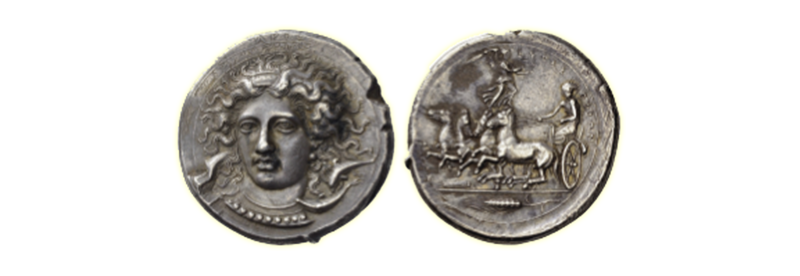Coinworld.com | By Jeff Starck | June 13, 2014

Coin from Syracuse realizes 2,737,000 Swiss francs
A silver tetradrachm of Syracuse, Sicily, sold May 26 in Zurich established, barely, a new record price for a Greek silver coin at auction.
The circa 405 to 400 B.C. coin, engraved by famed die artist Kimon, realized 2,737,000 Swiss francs (about $3,052,750 U.S.), including the 19 percent buyer’s fee. The coin was part of the David Walsh Collection, which composed auction No. 77 by Numismatic Ars Classica.
The coin’s price edged out the earlier record price, paid for a circa 409 to 406 B.C. decadrachm of Agrigentum, another seaside city-state in Sicily, set in a sale by the same firm in its auction No. 66 on Oct. 17, 2012.
Each coin had a hammer price of 2.3 million Swiss francs, but the buyer’s fee is now 19 percent, compared to 18 percent in the earlier auction. At the exchange rate of the time in 2012, the Agrigentum coin sold for the equivalent of $2,918,810 U.S.
The tetradrachm of Kimon is “the greatest masterpiece of Greek numismatic art and work of the most talented master-engraver of the period,” according to the auction house, which also described it as “the most beautiful Greek coin in private hands.”
Designs of a legend
The coin shows a facing-head view of Arethusa “the Saviour,” the water nymph, on the obverse, with playful dolphins darting through her floating strands of hair. Her headband bears the artist’s name.
Her appearance on the obverse temporarily reversed a century of practice that placed her on the reverse. According to Numismatic Ars Classica, the side depicting Arethusa may have been used as the reverse all that time to prevent damage to the reverse die; due to the method of striking coins used in ancient times, one die absorbed more of the force from the hammer blow, which could result in damage, including die cracks.
The reverse of the coin shows a victorious charioteer driving a quadriga, with Nike floating above, reaching out to crown the driver.
Katherine Erhart, in a dissertation on facing head Greek coins cited by the auction house, praised the design, calling it “easily the most beautiful coin of all time, one applauded by ancient die-engravers and modern critics alike. … No other engraver before or since has so magnificently exploited the compositional potential of the small circular coin flan.”



